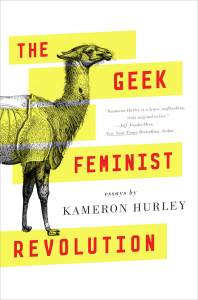The Exploding Spaceship Release Day Review of Empire Ascendant and an Interview with Kameron Hurley
← The Exploding Spaceship Reviews The Last Witness by K.J. ParkerThe Hardest Part: Alexandra Duncan on Sound, ahead of her appearance this Sunday at Flyleaf Books →
The Exploding Spaceship Release Day Review of Empire Ascendant and an Interview with Kameron Hurley
Posted on 2015-10-06 at 18:44 by angelablackwell
An interview with Kameron Hurley about her new novel Empire Ascendant
Exploding Spaceship: The universe of the Worldbreaker Saga has multiple cultures and you even have parallel world versions of those cultures. As writers ourselves, it seems a daunting task to keep everything straight when you are writing. How do you keep track of the cultural differences between parallel worlds?
Kameron Hurley: The worlds are actually very different – it’s the characters who share faces. Which may sound like it’s even more confusing until you realize how I build my novels. I often start with a character and then figure out what type of a world would have made that person into who they are – then I build the world around them. This was very true of the mercenary Nyx in my God’s War novels, too. I came up with the line “Nyx sold her womb somewhere between Punjai and Faleen, on the edge of the desert,” and I wanted to figure out what type of a world would produce that sort of person. Who would do something like that so casually? Everything that was the world of Umayma came from that, driven by her act.
This world was very similar, in that I had the characters of Ahkio and Lilia – an amorous young man with no interest in a title who teaches ethics to shepherds and a plain-faced young scullery girl with no family who dreams of a more compelling life – in my mind long before what would become the final version of the world of Raisa. Originally I didn’t find the world very compelling, and the narrative fell flat again and again. There was nothing to make the book stand out from any other fantasy book. When I went back and started building a world of sentient plants and satellite magic and polyamorous societies around them, the characters made more sense and the story was far more compelling.
To make the alternate world, I started again with the different versions of the characters, who needed to be single minded and ruthless. Whereas I had a pacifist polyamorous culture in a more or less predictably non-cataclysmic climate in one world that made one set of characters who they were, I created a militant, hierarchical culture with far more strict marriage rules and death raining down from the sky for the alternate. This had the result of realistically creating just the sorts of characters I needed to wage a genocidal campaign of attrition.
As for how I actually keep track of them, circling back to that question – I do have a wiki that my assistant maintains. It includes entries for any characters that have two (or more!) versions, and gives a brief rundown of their individual histories (or untimely demises).
ES: Your different cultures deal with genders in very different ways and some characters seem to have issues with pronoun usage, particularly when one culture doesn’t have the same gender definitions as the culture in which they are comfortable. We have similar issues in the real world and some languages deal with this much better than English does. Did you use any real world examples to help you define how your cultures deal with gender? Can you point to any useful resources on this issue that would be helpful for other writers in developing their own alien cultures’ gender descriptions?
KH: Plenty. I think this is where a lot of people get hung up when they read books with gender fluidity. We are so used to seeing this unchanging narrative that gender is and was always binary, and this is just bunk. Much of our obsession with binary gender is a recent invention, reinforced by a lot of more recent iterations of Abrahamic religions like Christianity. Some good places to start are books like Changing Ones: Third and Fourth Genders in Native North America and Delusions of Gender: How Our Minds, Society, and Neurosexism Create Difference. I could go on, but don’t want to overwhelm. When you finish those, just check out their bibliographies and start on down the rabbit hole.
ES: Your main character, Lilia, has several health issues. We liked seeing an asthmatic going on adventures, as we both suffer from it ourselves. She also has some more evident physical issues which restrict how fast she can move. Did you receive any pushback from people like your agent or editor about using a character with disabilities? If not, did you receive positive feedback on this issue from them?
KH: Funny enough, I haven’t received a lot of pushback about the gender or sexuality or ability or race of my characters from inside the publishing mountain. Some of this, I suspect, is an issue of privilege: I wonder often about whether or not I’d get pushback if I wasn’t white, or if I was in a same-sex relationship, and included the same sorts of people in my books. People judge writers and their work very, very differently based on who the writer is or presents as.
I do hear these stories of editor pushback more from marginalized writers. The only time, indeed, anyone expressed a concern was my agent in regards to my all-women space opera when she noted it wasn’t going to be an easy sell because, frankly, there were no men in it (we sold it anyway). And I do wonder, sometimes, if I’d been a Muslim writer or non-white writer and pitched God’s War what sort of comments we’d have gotten back from industry pros. You hear white male writers in particular carry on about how diversity is the hip new thing and they’re discriminated against now, and it makes me laugh, because if anything, white male writers are overly praised for writing stories about women, about people of color, in a way that other types of writers aren’t. It’s assumed that we will write about people like us. We don’t get gold stars for writing everybody like they’re a real human being the way guys, especially white guys, do.
Most of the positive feedback I’ve gotten about Lilia has indeed been from writers who suffer chronic conditions and disabilities, asthmatics in particular. In part, I wrote Lilia for my very young niece, who has really severe asthma that puts her in the hospital constantly. I wanted to have this little but tough and persistent character who isn’t good with a sword and has to manage a lot of physical limitations, and is nonetheless the real driving force of a save-the-worlds novel.
ES: Please tell us about future stories within this universe.
KH: The third and final book in the series, The Broken Heavens, will be out in fall of 2017. I’ve already started that one, and am on track to turn it in fall of 2016. If I finish earlier we may be able to get it on the docket earlier, but don’t count your chickens. 2016 is a massively busy year for me. In a good way!
ES: Please tell us about your other upcoming books, including your essay book with the cool cover.
KH: My essay collection, The Geek Feminist Revolution, will be out May 31st from Tor books, followed by that all-women space opera, The Stars Are Legion, in October of 2016 from Saga Press. Hoping we should have a cover of that one to share here before year’s end as well. Lots of exciting things in the works. Now I just need to hit my deadlines!
Review of Empire Ascendant: Worldbreaker Saga #2 by Kameron Hurley (Angry Robot, Oct 6, 2015)
In this volume the Tai Mora are attacking by sending as many people from their world with the dead star through winks as can go, and those already through are killing massive numbers of people in order to have blood for magic and so their people’s doubles will be dead. Kirana wants desperately to find the Yisaoh of the world so she can bring her consort from the other world over. The other side eventually discovers that the Tai Mora are searching for her and they use this as leverage to push for a meeting. The more peaceful people are no match for the army of the Tai Mora and their leaders are not good strategists so nothing works out as intended.
Lilia tries to help the Dhai fight the Tai Mora, but the methods she proposes to win are not to the liking of the peaceful Dhai. Although some try to do what she says, most don’t really understand why she is giving certain orders and they think she is too harsh. The Kai, Ahkio, does understand her methods but doesn’t have the backbone to force its implementation. He would rather be in the temple than fighting.
In this volume we see some more of the interesting aspects of the setting including temples which are alive, disgusting plants, nasty flying creatures, poisonous tubers, and satellites which suddenly appear a year ahead of schedule. The viewpoint is shared by many characters of different genders and from both sides of the war. The gender norms are different across the cultures and this enhances the feel of real places with live people, as it more accurately reflects a varied world.
Several characters meet the doubles of deceased people who were close to them. These are interesting encounters because the viewpoint character has some preconceived ideas about the double, but because of cultural differences they do not always hold true. They are just true enough to trip the characters up and make them think the double is just like the one they knew. How much the doubles are alike seems to depend on the personality and how similar the living circumstances were for the two.
The sensory input in the story is excellent with smells, sights and sounds all used well. The “feels” of the characters are complex and pull on your heart in several circumstances as some characters get injured, enslaved, or imprisoned in this volume. The setting comes alive and makes you feel wonder or disgust in about equal doses. This is epic fantasy at its best! Every fantasy reader should read this series!
Affliliate buy links which support both Bull Spec and your local independent bookstore: IndieBound [paperback, $14.99] and Kobo [ebook, $6.29]



